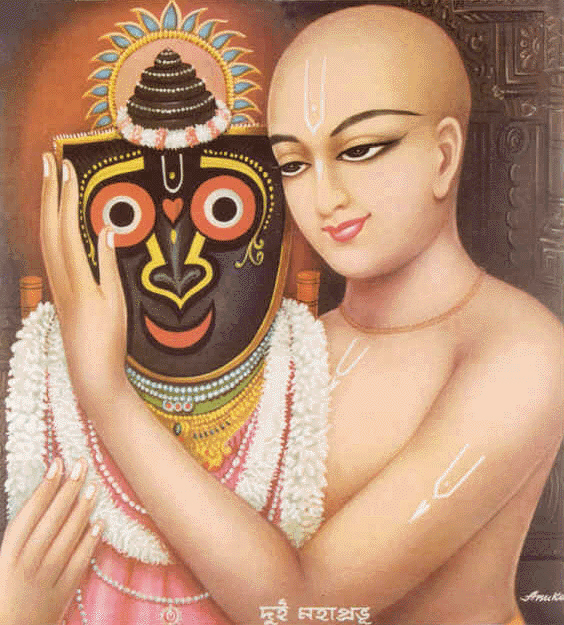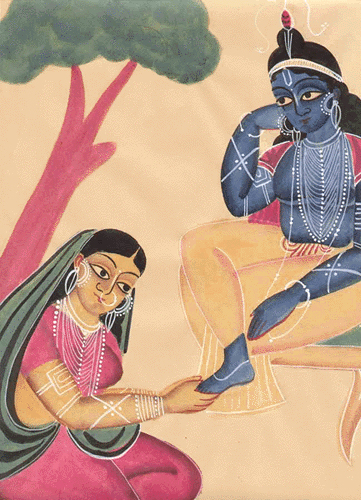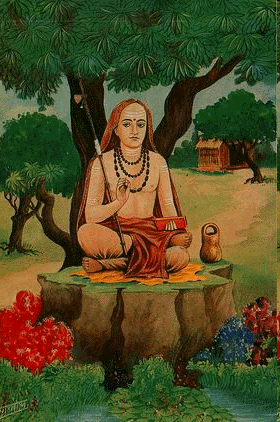
|
|
|
|
BY: SUN STAFF

Sri Caitanya Mahaprabhu Dec 13, CANADA (SUN) — 'Vaisnavite Movements' from IGNOU curriculum, Part 5. As described in the first segment of this series, "Vaisnavite Movements", we have been presenting the syllabus of curriculum offered by the Indira Gandhi National Open University (IGNOU) in New Delhi. The subject of Vaisnavism is presented by them in four main sections: Vaishnavism in Southern India, Western India, Northern India, and finally in Eastern India. Tonight, in the section on Eastern Vaisnavism, we will see most clearly certain philosophical aspects of IGNOU's curriculum that need to be adjusted and refined in order to present a more proper education to students on Vaisnavism. We hope the devotees will pursue the task of 'educating the educators' in this regard. IGNOU's 'Vaishnavism in Eastern India' "The form of Vaishnavism which developed in Bengal laid great emphasis on devotion and the love relationship between the devotee and Sri Krishna. This form of Vaishnavism is known as Gaudiya Vaishnavism and was initiated by Chaitanya. Chaitanya was born in the late 15th century in a place called Nabadwip, in Bengal, and as Nabadwip was a part of Gaud kingdom of medieval Bengal, so the Vaishnavism initiated by Chaitanya was known as Gaudiya Vaishnavism. By initiation Chaitanya belonged to the Madhva school, but his philosophical teachings were distinctly different from those of Madhva. It is suggested that before Chaitanya, Madhavendra Puri was a religious leader of the bhakti tradition in Bengal. Vaishnavism in Bengal owes its origin to Madhavendra Puri, who was an emotional Sankarite ascetic. Iswar Puri, a disciple of Madhavendra, turned Chaitanya towards Vaishnavism.

Sri Sri Radha Krsna Chaitanya inherited mystic emotionalism from these early mystic saints of Bengal. The doctrine of Chaitanya is called Acintya-bhedabhedavada, which has resemblance with the teachings of Nimbarka. He rejected the doctrine of Maya (illusion) and considered Krishna as the Supreme God and Radha as His energy. He advocated that the transformation of Brahman into the universe, as mentioned in the Brahmasutra is real in the same way as milk transforms into curd. Chaitanya’s ideas on bhakti are formulated on the basis of his biographies and the writings of the Vrindavana Goswamis like Sanatana, Rupa, Jiva, etc. Chaitanya had advocated Krishna-bhakti as a total form of religion and it is above all other religious injunctions. Bhaktiis explained as the objective as well as the ultimate end. One should completely dedicate oneself to Krishna and become dependent on Him for His grace to attain liberation. In Gaudiya Vaishnavism, bhakti is considered to be the highest obligation, and the four other obligations prescribed in the Hindu Shastras, namely – dharma, artha, kama and moksha are subordinates to bhakti. Krishna in His personal form – a cowherd boy, the beloved of Radha, is visualized as the ultimate reality. Chaitanya urged his followers to sing the name of Krishna as the simplest way of surrendering oneself to the Lord. He described bhakti as superior to jnana and jnana is considered as an effect and consequence of that bhakti. The emphasis is not on the scripture to understand the Absolute reality, but on Sadhana-bhakti, or practice of devotional service. Through devotion one can get rid of impurities and gradually move towards the ultimate goal of prema-bhakti. In the post-Chaitanya period, Vaishnavism in Bengal saw the emergence of the Sahajiya sect. In matters of theology, the Sahajiyas are in agreement with the Goswamis but in religious practices they adopt a different position. A follower of Sahajiya believes in the need of a woman other than his wife as a companion of his sadhana. He considers his companion as Radha and himself as Krishna, and tries to imitate the life of Radha-Krishna. This practice is not allowed in the scriptures of the orthodox sect. Unlike other Vaishnavas, Sahajiyas are not vegetarian. In Orissa also Vaishnavism became a strong religious tradition. Medieval Vaishnavism in Orissa centered on the worship of Jagannatha. Jagannatha was originally worshipped by the Savaras, a local tribe. Later on Raja Indradyumna started worshipping Jagannatha, and the present Jagannatha temple was constructed in the mid-Twelfth century A.D. It is said that Sankara visited Puri and established his dhama there. Ramanuja also visited Puri and thus Puri became a centre of Vaishnava faith, and Jagannatha got identified with Vishnu. The coming of Chaitanya to Puri added new fervour to Vaishnavism in Puri. Chaitanya stayed in Orissa for about 18 years and had great influence on religious life of the people. He popularized the Radha-Krishna worship in Orissa and visualized Lord Jagannatha as the incarnation of Lord Krishna.

Shankaracarya In eastern India, along with Bengal and Orissa, Assam witnessed a strong Vaishnava movement initiated by Shankaradeva. Assam being dominated by non-Aryan ethnic groups having less familiarity with complex religious rites of the brahminical religion was a suitable ground for Vaishnava religion. The bhakti doctrine with emphasis on singing, listening and remembering God was considered suitable for all sections of the local society. Shankaradeva spent 12 years outside Assam, visiting holy places and studying religious ideas. It is believed that he received spiritual initiation from a Vaishnava saint at Puri. He was influenced by the Bhagavata Purana and its philosophy of devotion centered around Vishnu or Krishna. Shankaradeva preached bhakti as a means and an end of human existence. Bhaktiis considered more important than knowledge, and knowledge comes automatically after reaching a certain stage of devotion. Shankaradeva did not advocate for renunciation of the world for the sake of liberation. To him, the highest religion is the religion of loving devotion to Krishna and this can be attained through practicing the life of a true Vaishnava. Emphasis was given to having a spiritual guide and the Nama (singing the name of personal God). Nama-dharma consisting of chanting the name of God with absolute devotion is suggested as the supreme religion. "Just as Madhva is the king among gods, so the chanting of the name is the supreme religion. Namadharma destroys sins committed through the crores of ages. So reiterate the name of Rama." The following song composed by Shankaradeva towards the end of his life very well reflects the main ideas of his Vaishnavism:
(Cited in Vaishnavism of Samkaradeva and Ramanuja by H.V. Sreenivasa Murthy) Shankaradeva believed in the doctrine of karma and to him, the suffering and pleasure of the human being is the result of one’s deeds. The tradition of Vaishnavism initiated by Shankaradeva in Assam was carried on after him by his disciples, and most notable of them was Madhavadeva."
| |